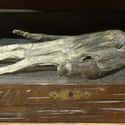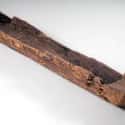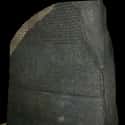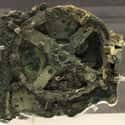-
(#14) The Whitby Museum's Hand Of Glory (c. 18th Century AD)
The Whitby Museum's Hand of Glory is not especially ancient, but it is a well-preserved example of an occult practice that dates back centuries (allegedly, it is also the only such hand to survive to the present day). The museum has a great, if gruesome, explanation of how these hands were purportedly used:
A Hand of Glory was supposedly the carefully prepared and "pickled" right hand of a felon, cut off while the body still hung from the gallows and used by burglars to send sleepers in a house into a [deep unconsciousness] from which they were unable to wake. In one version the clenched hand is used as a candleholder for a candle incorporating human fat, but in another (consistent with the Whitby hand) the outstretched hand has its own fingers lit. In this case should one of the fingers refuse to light it is a sign that someone in the household remains awake.
This hand was discovered in the early 1900s on the wall of a cottage in Castleton, England.
-
(#7) The Pesse Canoe (c. 8000 BC)
Believed to be the oldest-known boat in the world, and certainly the oldest canoe in the historical record, the Pesse canoe was discovered in Pesse, a village in the Dutch province of Drenthe, during the construction of a highway. The boat was carved out of a pine log roughly 10,000 years ago.
Carbon dating has placed the canoe's construction to the Mesolithic period, between 8040 BC and 7510 BC. A similar boat was discovered outside a village in Nigeria, dated some 2,000 years later.
-
(#1) Rosetta Stone
- Relief
This giant slab of basalt is where the Rosetta Stone language-learning program gets its name. Discovered by Napoleon Bonaparte's army in 1799, the slab contains a decree from King Ptolemy V (r. 204-181 BC) written in three different languages: Egyptian hieroglyphic, Egyptian Demotic (the "language of the people"), and ancient Greek (the language of Egypt's Greco-Macedonian rulers).
As the British Museum explains:
The importance of [the Rosetta Stone] to Egyptology is immense. When it was discovered, nobody knew how to read ancient Egyptian hieroglyphs. Because the inscriptions say the same thing in three different scripts, and scholars could still read Ancient Greek, the Rosetta Stone became a valuable key to deciphering the hieroglyphs.
-
(#2) The Antikythera Mechanism (c. 200-1 BC)
When it was first discovered at the beginning of the 20th century, the Antikythera Mechanism baffled archaeologists. It was a confusing muddle of modern-looking gears that had been resting at the bottom of the ocean for 2,000 years. Conspiracy theorists claimed it was evidence of a smashed alien vessel, while others thought it was a long-lost piece of Atlantean hardware. One investigator dubbed it an "ancient Greek computer," and time has proven that somewhat accurate.
It is now believed the mechanism was a kind of astronomical calculator. X-ray imaging and CT scans have revealed the device's interlocking gears were used to track the movement of the sun, moon, and planets visible to the naked eye. Inscriptions describe the dates when particular stars rise and set, and a dial on the back tracked lunar and solar eclipses.
-
(#13) The First Gutenberg Bible To Arrive In The United States (c. 15th Century)
One of the earliest mass-printed books, the Gutenberg Bible is a landmark in the history of humankind - and literacy in general. Of the 180 original Bibles, some 49 still exist today, 10 of which may be found in the United States.
The Bible pictured here, now on display at the New York Public Library, was bought by James Lenox in 1847. It was the first copy purchased by a US citizen.
-
(#12) A Jade Cong From The Liangzhu Culture (c. 3300-2200 BC)
Living in China's Jiangsu province in the third millennium BC, the Neolithic Liangzhu culture created items out of jade, ceramic, and stone that still exist today. Many "cong" objects have been found, exhibiting a circular inner shape and square outer section, but their use and significance remain mysterious. Several cong have been unearthed in Chinese tombs from the period.
Khan Academy describes these objects as "among the most impressive yet most enigmatic of all ancient Chinese jade artifacts." Also, they "were extremely difficult and time-consuming to produce. As jade cannot be split like other stones, it must be worked with a hard abrasive sand."
New Random Displays Display All By Ranking
About This Tool
While ancient times happened so long ago, some things never change. Over the years, archaeologists from all over the world have devoted themselves to excavating and exploring the history of human civilization. They have unearthed many valuable ancient cultural artifacts in a wide range, including tools, pottery, metal objects, personal items, etc. Cultural relics are relics and relics that reflect the material and spiritual culture of a nation.
The random tool shows 15 amazing artifacts from ancient times that reflect social development and social life from different aspects, and they are physical materials for studying the history of the ancient world.
Our data comes from Ranker, If you want to participate in the ranking of items displayed on this page, please click here.
















